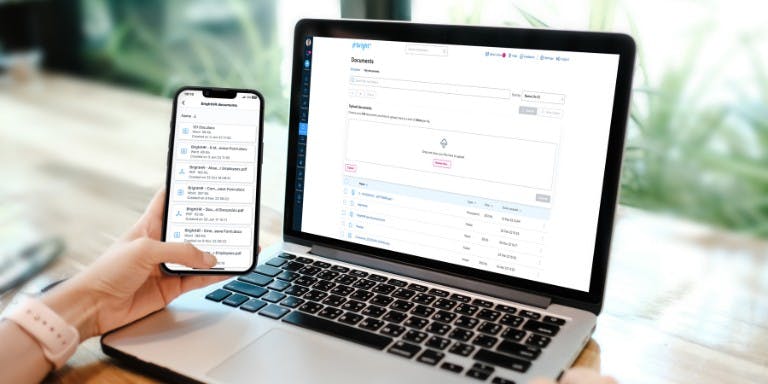First published on Thursday, August 15, 2024
Last updated on Thursday, August 15, 2024
Jump to section
- Employee documents all UK businesses must store
- Essential employee documents
- Personnel records and employee data protection
- Legal compliance documents
- Payroll and benefits documentation
- Workplace health & safety documents
- Retention periods and best practices for storing HR documents
- How BrightHR can help you with your HR documentation
Staying compliant with employment laws while managing employees can be a juggling act for any business. One crucial component that often gets overlooked is HR documentation.
As a business owner in the UK, you should make sure that all records are accurate, up-to-date, and compliant with the law. You are also legally required to store all documents securely.
That’s why we’ve created this guide to all the HR documents you need to keep and why it’s important to manage them effectively. From essential employee documents to legal compliance, we've got you covered.
Employee documents all UK businesses must store
First, this is a simple breakdown of each essential employment document you will need to store:
Hiring process documents
Job description: Detailed roles and responsibilities
Application forms: Completed job applications
Resumes/CVs: Applicant resumes or CVs
Interview records: Notes from interviews
Offer letter: Formal job offer
Employment contract: Signed employment agreement
Right-to-work documentation: Proof of eligibility to work in the UK
References: Reference checks
During employment
Employee handbook: Company policies and procedures
Training records: Documentation of training completed
Performance reviews: Regular performance evaluations
Leave records: Documentation of annual leave, sick leave, etc
Disciplinary records: Notes and outcomes of disciplinary actions
Payroll records: Details of salary and deductions
Benefits enrollment forms: Records of benefits chosen by the employee
Health and safety training records: Evidence of health and safety training
Emergency contact information: Updated contact details for emergencies
End of employment
Termination letter: Official notification of employment end
Exit interview records: Summaries and notes from exit interviews
Final payroll records: Last payment details, including severance if applicable
Pension and benefits records: Final contributions and benefits information
Reason for termination: Documentation of the reason for termination
Return of company property: Records showing the return of company property
Reference letter: If provided, a letter of reference
That's a lot of documents. Thankfully, this is where digital HR solutions like Bright HR's document storage product come in handy.
With it, you can confirm critical updates with alerts, read receipts, view essential documents anytime, anywhere, and keep your confidential information secure. Plus, if you need help creating any employment document for your business, BrightHR has an online HR document library packed with HR documentation templates you can customise to suit your needs.
Proper documentation is not just about ticking boxes; it's about creating a transparent, efficient, and legally secure work environment. Let's explore the why of storing these documents.
Essential employee documents
Contracts of employment
Employment contracts, including full-time and fixed-term contracts, provide clarity by outlining the terms and conditions of employment, including duties, salaries, and working hours. This helps to manage expectations on both sides, reducing the likelihood of misunderstandings or disputes.
Not to mention, it’s a legal requirement that a statement of main terms is provided to all new employees before employment starts.
Offer Letters and job descriptions
Offer letters officially confirm employment, while job descriptions outline specific roles and expectations. Together, they should set the tone for the employer-employee relationship.
Employee handbooks
An employee handbook informs staff about company policies and procedures. It serves as a reference point for everything from dress codes to grievance procedures, promoting consistency and fairness. This is your 'company bible'.
Why not download a FREE employee handbook template for your business.
Personnel records and employee data protection
Secure storage of employee information
Personnel records include sensitive personal details, emergency contacts, and employment history. These records must be stored securely to protect employee privacy and comply with data protection laws.
Additionally, it is important to securely store certain documents that may need to be provided at the end of employment, such as certificates of appreciation and recommendation letters.
Maintaining data integrity
Accurate and up-to-date records are essential. Regular audits and updates ensure the information remains reliable and compliant with the General Data Protection Regulation (GDPR) and the Data Protection Act 2018. Implementing periodic reviews to maintain data accuracy and integrity will put you in good stead regarding compliance challenges.
Confidentiality in HR documentation
Only authorised personnel should have access to employee records. Maintaining confidentiality not only builds trust but also safeguards against legal repercussions. Ensuring that data protection measures are in place, as advised UK legislation, is vital for maintaining compliance.
Legal compliance documents
Right-to-work checks
You must verify that employees have the legal right to work in the country. This includes checking passports, visas, and other relevant documents. Proper documentation helps protect the company from legal challenges related to employment eligibility and other compliance issues.
Proof of eligibility and qualification records
Keeping records of qualifications and certifications ensures that employees meet the necessary standards for their roles, which is vital for compliance and performance.
Payroll and benefits documentation
Employee compensation documents
Accurate payroll records, including salaries, bonuses, and deductions, are a must for tracking employee compensation. This transparency prevents disputes and ensures compliance with tax regulations.
Pension contributions and tax forms
Documenting pension contributions and tax forms is a must for financial compliance. It also helps employees understand their benefits and tax obligations.
Financial transparency in payroll
Precise and accurate payroll documentation fosters accountability within the organisation, making financial audits smoother and more efficient.
Workplace health & safety documents
Risk assessments and accident reports
Documenting risk assessments and accident reports will help SMEs identify other potential hazards and prevent future incidents. Commit to regular updates and thorough documentation to manage workplace safety effectively.
Compliance with health & safety regulations
Adhering to health and safety laws protects employees and minimises the risk of legal action against the company. Proper documentation ensures that all safety protocols are followed and recorded accurately.
Employee welfare documentation
Documents related to workplace health and safety contribute to a safer work environment, enhancing employee well-being and productivity. These records are vital for creating a workplace safety and health culture.
Retention periods and best practices for storing HR documents
According to UK laws, different types of HR documents have varying document retention periods. For example, payroll records should be kept for at least three years, while employee contracts may need to be retained for seven years after termination.
Although the retention periods can vary it’s recommended you retain all employee documentation for seven years after employment ends, in case a dispute arises.
Best practices for document storage
Store HR documents in a secure, accessible manner. Digital storage solutions with encryption and access controls are preferable to physical storage, ensuring security and ease of access.
Ensuring accessibility and compliance
Properly maintained HR records should be easily accessible to authorised personnel while remaining fully compliant with data protection regulations. The UK government's data protection guidelines stress the importance of secure and compliant storage practices.
How BrightHR can help you with your HR documentation
HR documentation is crucial for any business. And that’s why we’re help. With our HR software you get a centralised system for organising, accessing, and ensuring compliance with all HR documents—ultimately reducing administrative burdens and helping maintain a legally secure work environment.
You’ll also have access to an online library of HR document templates that can be easily customised to meet your business needs. Plus, with unlimited storage, instant updates, alerts, and read receipts all critical documents are easily accessible whenever needed.
Data protection is a priority for us, and we make sure all personnel records are securely stored with advanced encryption and access controls, helping comply with GDPR and building employee trust by maintaining data confidentiality.
But it’s not just HR documents we can help with. We also have you covered for workplace health & safety with our BrightSafe software that’s easy to manage and access to documentation of risk assessments, accident reports, and health & safety records. Keeping you in line with safety regulations and maintaining a safe work environment—enhancing employee wellbeing.
Ready to transform your HR document management? Book a demo today and discover how we can support your business.








